Thymus-related Cells Persist After Thymectomy in MG, Study Finds

Immune B-cells originating in the thymus continue to circulate in the blood after thymectomy, causing a diminished clinical response to treatment in people with myasthenia gravis (MG), a study has found.
In a commentary about the study, Robert Lisak, MD, and David Richman, MD, wrote that “it supports the theory that thymectomy should be performed early in the course of the disease before a large number of [disease-causing cells] have seeded the peripheral immune system.”
The study, “Thymus-derived B cell clones persist in the circulation after thymectomy in myasthenia gravis,” was published in the journal PNAS.
MG is caused by the production of self-reactive antibodies that attack the sites of communication between nerve and muscle cells. The acetylcholine receptors (AChR), which facilitate this communication, are the most frequent targets in MG. The thymus, an organ critical to immune response, is a key source of such anti-AChR autoantibodies derived from B-cells.
AChR-linked MG is associated with thymus abnormalities, with the majority of patients having hyperplastic thymus (an enlarged thymus gland).
Due to its disease-causing role in MG, removal of the thymus, or thymectomy, is a treatment option. In a Phase 3 clinical trial (NCT00294658) known as MGTX and assessing the outcomes of thymectomy in MG, patients experienced durable benefits and used fewer steroids following the procedure. However, the extent of the benefits was variable across the participants.
To better understand the diversity of patient outcomes following thymectomy, researchers at Yale University analyzed the B-cell population from the thymus before and after thymectomy in people with MG. They speculated that a portion of these cells may persist in the bloodstream even after thymus removal, corresponding with disease persistence.
Eight patients were selected randomly from the 82 MGTX trial participants (mean age 23.6); seven were women. A 36-year-old woman who underwent thymectomy, but did not take part in MGTX, also was included.
Thymus B-cells in MG patients had characteristics that differentiate them from B-cells circulating in the blood, including a higher proportion of switching to generate antibodies of the IgG type and an accumulation of mutations.
B-cells in the thymus shared specific identifying genetic sequences with circulating cells, suggesting a common genetic ancestry. In the seven patients analyzed, a mean of 2.1% of thymus cells were relatives of cells in circulation.
DNA sequencing confirmed that, prior to thymectomy, a proportion of cells in circulation are related to thymus B-cells. Also, the thymus-related B-cells in the blood shared characteristics with those in the thymus, as assessed by the percentage of cells switched to produce IgG antibodies and with mutations.
To determine the fate of these thymus-related circulating B-cells following thymectomy, thymic tissue and blood were collected before treatment, and one year after. After thymectomy, a mean of 1% of thymus B-cells shared genetic similarities with circulating B cells, compared to average sharing 0.046% in unrelated individuals. This suggests that thymus-related B-cells continue in the bloodstream after thymectomy.
Five of the seven patients assessed had a smaller proportion of thymus-related B-cells in the blood one year after thymectomy. Further analysis suggested that such cells mature in the thymus before moving to circulation.
Patients with greater reductions in the fraction of thymus-related circulating B-cells after thymectomy had better clinical outcomes than those with little to no decrease. Larger decreases corresponded with reduced MG severity and steroid use between one to two years after thymectomy.
“Diagnostic algorithms incorporating thymus imaging after thymectomy and [B cell receptor] repertoire evaluation may provide a means to assess the potential need for surgical re-exploration versus further immunotherapy. Thus, tracking the persistence of thymic-derived B cells after therapy may represent an invaluable bio-marker for the management of patients with AChR-MG,” the researchers wrote.
Among the study’s limitations is the possibility of misidentifying some related cells between different tissue types, the noted.






